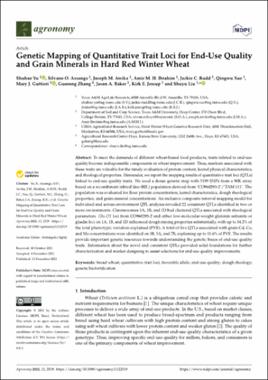| dc.contributor.author | Yu, Shuhao | |
| dc.contributor.author | Assanga, Silvano O. | |
| dc.contributor.author | Awika, Joseph M. | |
| dc.contributor.author | Ibrahim, Amir M. H. | |
| dc.contributor.author | Rudd, Jackie C. | |
| dc.contributor.author | Xue, Qingwu | |
| dc.contributor.author | Guttieri, Mary J. | |
| dc.contributor.author | Zhang, Guorong | |
| dc.contributor.author | Baker, Jason A. | |
| dc.contributor.author | Jessup, Kirk E. | |
| dc.contributor.author | Liu, Shuyu | |
| dc.date.accessioned | 2022-10-18T21:43:21Z | |
| dc.date.available | 2022-10-18T21:43:21Z | |
| dc.date.issued | 2021-12-11 | |
| dc.identifier.citation | Yu, S., Assanga, S.O., Awika, J.M., Ibrahim, A.M.H., Rudd, J.C., Xue, Q., Guttieri, M.J., Zhang, G., Baker, J.A., Jessup, K.E., Liu, S. Genetic Mapping of Quantitative Trait Loci for End-Use Quality and Grain Minerals in Hard Red Winter Wheat. Agronomy, 11(12), pp. 2519-. https://doi.org/10.3390/agronomy11122519 | |
| dc.identifier.uri | https://hdl.handle.net/11244/336550 | |
| dc.description.abstract | To meet the demands of different wheat-based food products, traits related to end-use quality become indispensable components in wheat improvement. Thus, markers associated with these traits are valuable for the timely evaluation of protein content, kernel physical characteristics, and rheological properties. Hereunder, we report the mapping results of quantitative trait loci (QTLs) linked to end-use quality traits. We used a dense genetic map with 5199 SNPs from a 90K array based on a recombinant inbred line (RIL) population derived from ‘CO960293-2’/‘TAM 111’. The population was evaluated for flour protein concentration, kernel characteristics, dough rheological properties, and grain mineral concentrations. An inclusive composite interval mapping model for individual and across-environment QTL analyses revealed 22 consistent QTLs identified in two or more environments. Chromosomes 1A, 1B, and 1D had clustered QTLs associated with rheological parameters. Glu-D1 loci from CO960293-2 and either low-molecular-weight glutenin subunits or gliadin loci on 1A, 1B, and 1D influenced dough mixing properties substantially, with up to 34.2% of the total phenotypic variation explained (PVE). A total of five QTLs associated with grain Cd, Co, and Mo concentrations were identified on 3B, 5A, and 7B, explaining up to 11.6% of PVE. The results provide important genetic resources towards understanding the genetic bases of end-use quality traits. Information about the novel and consistent QTLs provided solid foundations for further characterization and marker designing to assist selections for end-use quality improvements. | |
| dc.format | application/pdf | |
| dc.language | en_US | |
| dc.publisher | MDPI | |
| dc.relation.ispartof | Agronomy, 11 (12) | |
| dc.relation.uri | http://dx.doi.org/10.3390/agronomy11122519 | |
| dc.rights | This material has been previously published. In the Oklahoma State University Library's institutional repository this version is made available through the open access principles and the terms of agreement/consent between the author(s) and the publisher. The permission policy on the use, reproduction or distribution of the material falls under fair use for educational, scholarship, and research purposes. Contact Digital Resources and Discovery Services at lib-dls@okstate.edu or 405-744-9161 for further information. | |
| dc.title | Genetic mapping of quantitative trait loci for end-use quality and grain minerals in hard red winter wheat | |
| dc.date.updated | 2022-09-30T03:38:19Z | |
| dc.identifier.doi | 10.3390/agronomy11122519 | |
| dc.description.department | Horticulture and Landscape Architecture | |
| dc.type.genre | Article | |
| dc.type.material | Text | |
| dc.subject.keywords | Genetics | |
| dc.subject.keywords | Cardiovascular | |
| dc.subject.keywords | Environmental Science and Management | |
| dc.subject.keywords | Crop and Pasture Production | |
| dc.identifier.author | ORCID: 0000-0003-2955-1503 (Yu, Shuhao) | |
